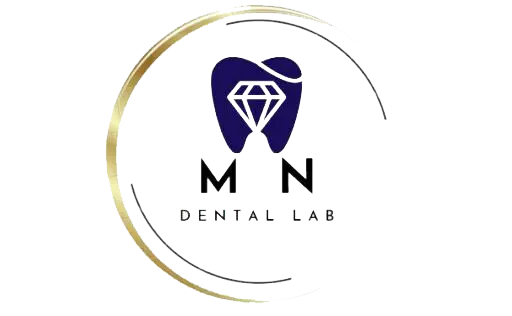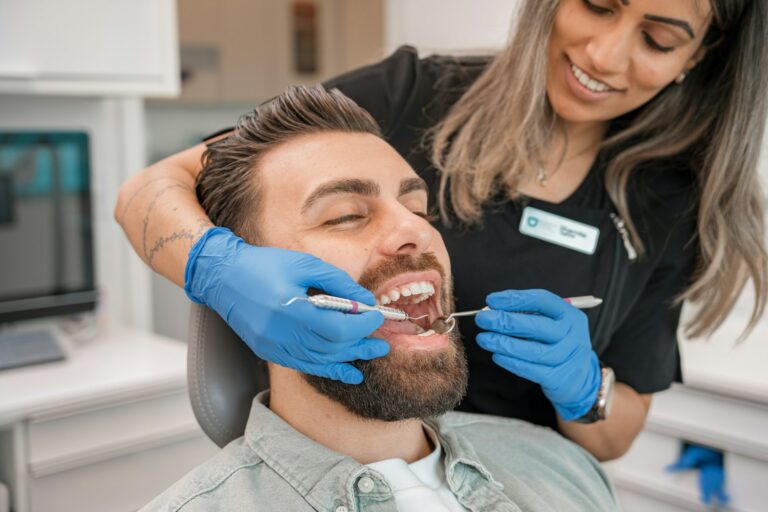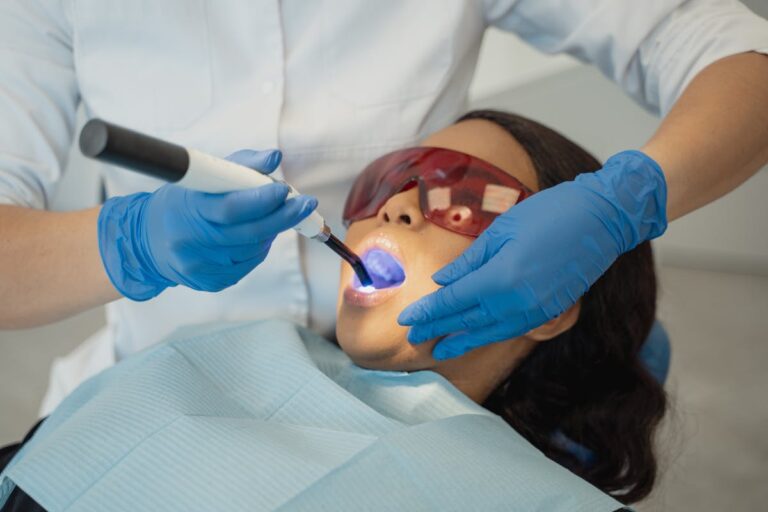The interplay between orthopedic health and dental restorations is an underexplored area in the current health discourse. While dental restorations – including crowns, bridges, and implants – primarily aim at improving oral health, they may inadvertently contribute to orthopedic issues. This correlation emerges from the potential of dental restorations to disrupt normal bite function, thereby causing musculoskeletal strain. This strain, in turn, might precipitate changes in posture and spinal alignment, which could lead to chronic discomfort or pain. A thorough exploration of this association is warranted for holistic patient care.
Understanding Dental Restorations
Within the domain of dentistry, dental restorations play an essential role, comprising an array of treatments designed to repair or replace damaged or missing teeth. These procedures are critical to the maintenance of ideal oral health, functionality, and aesthetics.
The success of dental restorations lies in the choice and application of appropriate dental materials and restoration techniques. Dental materials, including amalgams, composites, ceramics, and alloys, are chosen based on their properties and the specific needs of the patient. For instance, amalgams are durable and resistant to wear, making them suitable for large cavities in back teeth. Conversely, composites are preferred for front teeth due to their aesthetic appeal.
Restoration techniques vary from direct to indirect methods. Direct techniques involve the placement of a restorative material into the cavity during a single visit, while indirect techniques require the creation of restorations outside the mouth, which are later bonded to the tooth.
Understanding these principles is paramount in achieving effective dental restorations. However, the impact of orthopedic issues on these procedures remains a critical area of study, marking a fascinating intersection of dentistry and orthopedics.
Basic Orthopedic Issues Overview
In the context of orthopedics and its intersection with dentistry, it is critical to comprehend the fundamental aspects of orthopedic issues. These could range from common conditions such as arthritis and osteoporosis to more complex musculoskeletal disorders. Understanding the impact of orthopedic problems on dental health facilitates the implementation of effective dental restoration procedures, considering the potential impact on overall skeletal health.
Understanding Orthopedic Problems
Grasping the complexity of orthopedic problems is essential to understanding the broader landscape of human health. These problems relate to the musculoskeletal system, which comprises bones, muscles, joints, ligaments, and tendons. The intricate interplay between these components allows for core functions such as movement and stability.
An integral part of understanding orthopedic issues involves posture assessment. This is a systematic evaluation of the body’s alignment from a frontal, sagittal, and transverse perspective. Poor posture can lead to orthopedic problems as it places undue stress on particular body parts, specifically the spine, causing pain and dysfunction over time.
Jaw alignment is another critical aspect within orthopedics, despite being often overlooked. The alignment of the jaw can impact overall body posture and lead to various orthopedic issues. For instance, a misaligned jaw can cause an uneven distribution of forces when chewing, which can propagate through the neck to the spine, potentially leading to musculoskeletal complaints.
Therefore, understanding orthopedic problems requires a holistic approach, considering all aspects of body alignment. This includes seemingly unrelated areas, such as the jaw, which can have far-reaching effects on the body’s biomechanical functioning.
Common Orthopedic Conditions
The human body’s complexity often manifests in the form of common orthopedic conditions that challenge both patients and medical professionals alike. Knee pain, for instance, is a widespread issue that can stem from different causes such as joint inflammation or muscle tension. The complexity deepens when considering that knee pain might be a byproduct of hip dysfunction or ankle instability, hence requiring a thorough gait analysis to pinpoint the problem’s root.
Similarly, hip dysfunction is another typical orthopedic condition. It can cause chronic pain and mobility issues, greatly impacting the quality of life. Often linked with posture correction needs, hip dysfunction can also influence spine alignment, necessitating an integrated approach to treatment.
Spine alignment issues, on the other hand, are frequently associated with muscle tension and posture problems. Chronic pain and mobility issues often accompany these conditions, further exacerbating the patient’s discomfort.
Lastly, ankle instability can lead to altered gait patterns, causing a ripple effect of orthopedic issues throughout the body. As a result, a detailed understanding of these common orthopedic conditions is essential in devising effective treatment plans, aiming to alleviate pain and restore functionality.
The Human Body’s Interconnectedness
The human body’s interconnectedness is an intricate network of systems, each influencing and being influenced by others. This principle becomes particularly compelling when considering the connection between dental and orthopedic health, a link that has significant implications for both fields. A thorough understanding of these interrelationships can greatly enhance holistic medical approaches, fostering ideal patient outcomes.
Understanding Body’s Interconnected Systems
Delving into the complexities of the human body, one quickly comes to realize the intricate interconnectedness of its various systems. This network of connections, which contributes to our overall wellness, is essential for systemic health. For instance, dental alignment can greatly influence body mechanics. Malocclusions, or misalignments in the teeth, can alter bite impact, leading to muscle tension and even changes in posture.
The pain pathways are another important aspect of this interconnectedness. A misaligned bite can irritate nerve connections, leading to persistent pain not only in the jaw but also in seemingly unrelated areas like the neck and back. In addition, abnormal muscle tension can affect joint stability, potentially leading to issues like temporomandibular joint disorders.
The posture effects resulting from dental alignment problems can also exacerbate orthopedic issues. A poor bite can lead to a forward head posture, which puts additional strain on the neck and shoulder muscles, potentially causing further systemic health issues. Understanding these interconnected systems can help clinicians to approach patient care holistically, keeping an eye on the potential orthopedic implications of dental restorations.
Linking Dental and Orthopedic Health
Building upon our understanding of the body’s interconnected systems, one can start to appreciate the profound interrelationship between dental and orthopedic health. The intricate link between these two seemingly disparate fields is becoming increasingly clear as more research is conducted. It is essential to understand that both the dental and orthopedic systems are part of the overall musculoskeletal structure of the human body.
In this regard, bite alignment and jaw function play a significant role. Abnormalities in bite alignment can lead to a cascade of negative effects on the musculoskeletal system. For instance, a misaligned bite can cause undue stress on the jaw muscles, leading to jaw dysfunction. This, in turn, can lead to irregular posture, spinal misalignment, and eventually to orthopedic issues such as chronic back pain or osteoarthritis.
Conversely, orthopedic problems can also impact dental health. For example, conditions that affect bone health, such as osteoporosis, can lead to tooth loss due to a decrease in jawbone density. Consequently, a balanced and healthy functioning of both dental and orthopedic systems is essential for overall wellbeing. It is this interconnectedness that underlines the importance of integrated healthcare approaches in addressing these issues.
Implications for Holistic Medicine
Recognizing the inherent interconnectedness of the human body illuminates the importance of a holistic approach to medicine. This approach examines the whole person, their physical, emotional, mental, and spiritual wellbeing, acknowledging that each aspect influences the others. It underscores the significance of integrative therapies, which combine conventional and complementary treatments that are scientifically validated to be safe and effective.
In the context of orthopedic issues and dental restorations, the potential interconnectedness suggests that dental restorations may have systemic health implications beyond the oral cavity. For instance, a misaligned dental restoration could potentially lead to posture irregularities or other orthopedic problems, underscoring the need for holistic consideration in treatment planning.
Holistic practitioners, through integrative therapies, can address these issues by considering the potential effects of dental restorations on the body’s systemic health. This can lead to more effective treatments that not only address the immediate issue but also prevent potential orthopedic complications.

Studies Linking Dental and Orthopedic Health
In the domain of medical research, a growing body of evidence suggests a significant link between dental and orthopedic health. The correlation can be traced back to the interrelationship between dental alignment, craniofacial relations, and the functioning of the temporomandibular joint.
Numerous studies have highlighted the following three main areas of connection:
- Bite Issues and Posture Influence: Misalignment in dental occlusion, known as occlusal discrepancies, can lead to changes in body posture. This happens as the body tries to compensate for the imbalance, potentially causing a cascade of orthopedic issues.
- Jaw Dysfunction and Muscle Tension: Jaw dysfunctions, particularly those related to the temporomandibular joint, can increase muscle tension in the neck and shoulders, contributing to chronic pain and other musculoskeletal issues.
- Systemic Inflammation: Poor dental health can lead to systemic inflammation, which in turn, may exacerbate orthopedic conditions such as osteoarthritis and rheumatoid arthritis.
These findings underscore the necessity for an integrative approach to patient care. By recognizing the influence of dental health on orthopedic conditions, practitioners can better diagnose, manage, and potentially prevent a range of musculoskeletal issues.
Dental Restorations: Potential Risks
Often, dental restorations are a necessary intervention to correct dental health issues. However, as with any medical procedure, potential risks must be acknowledged. One significant area of concern lies in the choice of restoration materials. While these materials are designed to mimic natural teeth both in function and aesthetics, they can sometimes cause adverse reactions. Allergic reactions, sensitivities, and biocompatibility issues may arise, leading to inflammation, pain, and other health complications.
Another potential risk is related to bite alignment. Dental restorations should ideally restore the patient’s normal bite and guarantee proper alignment to avoid undue stress on the jaw joint and muscles. However, if the restorations are not correctly aligned, it can lead to malocclusion. This condition not only affects oral health but can also have far-reaching implications for orthopedic health. Issues such as temporomandibular joint disorders, neck pain, and headaches can stem from a misaligned bite.
Case Studies: Orthopedic Problems After Dental Procedures
Delving into the domain of orthopedic problems post-dental procedures, a number of case studies have begun to shed light on this complex interaction. The following narratives illustrate the intricate link between dental alignment and joint pain.
- In a study published by the Journal of Oral Rehabilitation, a patient who underwent an ill-fitted dental bridge experienced persistent temporomandibular joint (TMJ) pain. Subsequent orthopedic assessment revealed that the dental misalignment had elicited biomechanical changes, leading to the joint discomfort.
- Another case featured in the Journal of Orthopaedic Science highlighted a subject with no prior joint issues. Post-dental extraction, the patient developed persistent shoulder pain. Extensive orthopedic evaluation traced the pain source to the dental procedure, suggesting a possible link between oral intervention and remote joint pain.
- The American Journal of Orthopedics presented a case where a patient developed knee pain following dental braces installation. The misalignment caused by the braces resulted in an altered gait, subsequently leading to the knee pain.
These case studies underscore the potential orthopedic implications of dental procedures. Consequently, dental and orthopedic professionals should work synergistically to minimize potential adverse effects while optimizing patient care.
Proactive Measures for Dental Patients
Regularly, dental patients may not be fully aware of the orthopedic implications linked to certain dental procedures. Proactive measures that encompass both preventive dental care and patient education can greatly mitigate these potential risks.
Preventive dental care is paramount as it helps in early detection and treatment of dental issues before they escalate into orthopedic complications. It includes regular dental check-ups, cleanings, and targeted treatments such as fillings and sealants. Use of modern imaging technologies can aid in identifying underlying issues that might not be visible during a standard oral examination.
On the other hand, patient education is an equally critical aspect of proactive measures. Enhanced knowledge about the relationship between dental health and orthopedics can lead to better choices and practices, thereby reducing the possibility of orthopedic issues. This involves understanding the potential risks of certain dental procedures, recognizing early signs of complications, and knowing when to seek medical attention.
Orthopedic Care After Dental Restoration
While proactive measures play an essential role in mitigating the potential risks of dental procedures, post-procedure orthopedic care is equally significant, particularly after dental restoration. The objective of this care is to support post-restoration recovery and minimize any potential orthopedic issues that could arise.
Three central components of post-procedure orthopedic care include:
- Regular Follow-ups: These appointments enable the dentist to monitor recovery progress, manage any arising issues, and adjust treatment plans as necessary.
- Pain Management Strategies: These could encompass medication regimes, physical therapy, or alternative therapies such as acupuncture. Each patient’s pain management strategy should be personalized to guarantee maximum comfort and minimal disruption to daily life.
- Patient Education: This involves informing the patient about signs of potential complications and best practices for oral hygiene to support healing and prevent further issues.
Orthopedic care after dental restoration is therefore a multidimensional approach that combines regular check-ups, effective pain management strategies, and patient education. This thorough care not only assists in the speedy recovery of dental functions but also helps to prevent orthopedic issues that may indirectly be linked to dental restorations.
Advancements in Holistic Health Approach
Healthcare evolution, particularly the advancements in the holistic health approach, has profoundly impacted the fields of orthopedics and dentistry. This thorough perspective on health and wellness encompasses both physical and mental well-being, forming the basis of integrative therapies. These therapies involve a blend of conventional and alternative methods, focusing on treating the whole person rather than just the symptoms.
The relationship between orthopedic issues and dental restorations has been studied through a holistic lens, revealing potential connections and shared risk factors. For instance, inflammation associated with gum disease can potentially affect joint health, providing a compelling example of the body’s interconnectedness.
Patient education plays a crucial role in this approach, empowering individuals with knowledge about their health and well-being. A well-informed patient can make informed decisions about their treatment options, lifestyle changes, and preventive measures. This participatory aspect strengthens patient-provider relationships, fostering trust and collaboration.
These advancements illuminate the potential for a more integrated, personalized approach to healthcare. By connecting the dots between dental and orthopedic health through a holistic lens, we can pave the way for better patient outcomes, enhanced care quality, and a more profound understanding of the human body’s complexity.
Frequently Asked Questions
What Materials Are Commonly Used in Dental Restorations?
Commonly used restoration materials in dental procedures include amalgam, gold, porcelain, and dental composites. Dental composites, in particular, are widely utilized due to their aesthetic appeal and durability in restoring teeth structure.
Can Orthopedic Issues Affect Children Who Undergo Dental Restorations?
Orthopedic implications could potentially impact pediatric dental restorations, though research is limited. It’s essential to evaluate each child’s unique situation, considering their overall health, including any orthopedic conditions, prior to undertaking dental restoration procedures.
Are There Insurance Plans That Cover Both Dental Restorations and Orthopedic Treatments?
Yes, extensive health insurance plans often cover both dental restorations and orthopedic treatments. The extent of coverage varies, so it’s important to review policy details for specifics about these treatment options.
How Is Orthopedic Health Monitored After a Dental Restoration Procedure?
Orthopedic health, post dental restoration, is monitored through post-operative assessments. These assessments focus on patient recovery, including potential changes in posture, alignment, and mobility that might indicate orthopedic complications arising from the procedure.
Can Dental Restorations Impact Athletic Performance Due to Potential Orthopedic Problems?
While further research is required, some studies suggest that dental biomechanics could potentially influence orthopedic health, potentially impacting athletic performance. However, the link between dental restorations and athletic injuries remains unclear and largely theoretical.


